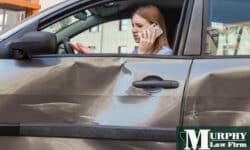
Understand how liability is determined in Montana rollover accidents and the steps to take to protect your right to compensation
Rollover crashes are among the most devastating types of accidents, often resulting in catastrophic injuries or even fatalities. While the risk of such accidents in Montana is heightened by factors like rural roads, rugged terrain, and inclement weather, driver negligence remains an all-too-common cause.
If you or a loved one has been involved in a rollover crash caused by someone else’s negligence, it’s crucial to take certain steps so you don’t lose your chance to be compensated. This article will provide essential information on the most common causes of these accidents, how liability is determined in Montana, and what you can do to protect your legal rights and get the compensation you deserve.
What percent of rollovers are fatal?
Rollover crashes are particularly deadly, with a significantly higher fatality rate compared to other types of crashes.
According to the National Highway Traffic Safety Administration, while only about 3% of crashes involve rollovers, these accidents account for approximately 20% of all fatal car accidents and about 33% of crash-related injury costs in the U.S. annually.
Why are rollovers so fatal?
Rollovers are particularly dangerous because they often result in occupants being ejected from the vehicle or crushed by the vehicle itself. The multiple impacts and violent forces involved in a rollover crash significantly increase the risk of severe and fatal injuries.
What are the odds of surviving a rollover car crash?
While rollover crashes are deadlier than other car accidents, the good news is that wearing a seatbelt can greatly increase your chance of survival.
According to the NHTSA, in about 75% of fatal rollover crashes, the victims were not wearing seatbelts at the time of the accident.
These statistics highlight the critical importance of seatbelt use in preventing ejections and reducing fatalities in such high-risk incidents.
What vehicles have the highest rollover risk?
Due to their higher centers of gravity, vehicles like SUVs, pickup trucks, and 15-passenger vans are more likely to rollover in an accident. Their taller, narrower design makes them less stable compared to lower-profile vehicles, especially during sharp turns, sudden swerves, or when encountering uneven road conditions.
While any vehicle can roll over under extreme circumstances, these high-profile vehicles are inherently more vulnerable due to their design and weight distribution.
What is the most common cause of rollover accidents?
The most common cause of a rollover is driver error, particularly in rollover accidents that only involve a single vehicle. These crashes typically occur when a driver loses control of the vehicle, leading to a sudden maneuver that causes the vehicle to tip over.
Speeding, distracted driving, and impaired driving are significant factors contributing to driver error in these incidents.
Other common causes of rollover accidents include:
- Poor weather. Certain weather conditions, such as rain or ice, can reduce traction and increase the likelihood of a rollover.
- Road hazards. Objects or uneven surfaces on the road, such as curbs or soft shoulders, can cause a vehicle to trip and roll over.
- Vehicle malfunction. Mechanical failures, such as tire blowouts or brake failures, can lead to a loss of control and increase the risk of a rollover.
Additionally, improperly loaded cargo in commercial trucks can affect a vehicle’s balance, making it more susceptible to tipping over.
A Guide to Montana’s Distracted Driving Laws & Compensation
Understand how Montana’s stance on texting and driving impacts your liability and compensation after an accident.
What are the most common injuries in a rollover crash?
Accident victims fortunate enough to survive a rollover crash are unfortunately often left with severe and life-altering injuries. The most common injuries in a rollover crash include:
- Spinal cord injuries. The twisting and bending of the spine during a rollover can result in partial or complete paralysis, altering a person’s life irrevocably.
- Head injuries. Traumatic brain injuries (TBIs), concussions, and skull fractures are common due to the violent impact and potential contact with the vehicle’s interior or the ground.
- Neck injuries. Whiplash and other neck injuries are common due to the sudden and forceful movements during a rollover.
- Broken bones. Fractures of the arms, legs, ribs, and pelvis are frequent due to the force of the crash and the vehicle rolling over multiple times.
- Internal injuries. Damage to internal organs, such as the lungs, liver, and kidneys, can result from the intense force and impact during a rollover crash.
- Amputation injuries. Severe trauma during a rollover can lead to partial or complete amputation of limbs, often resulting from being crushed or trapped during the crash.
- Lacerations and bruises. Deep cuts, bruises, and abrasions often occur from broken glass, debris, and the vehicle’s interior.
Because these injuries often require extensive medical treatment and can lead to long-term or permanent disability, it’s crucial to discuss your legal options with an experienced personal injury attorney if you believe someone else’s negligence caused the accident.
An attorney can help you understand your rights, navigate the complex legal process, and ensure you receive the compensation you need for medical expenses, lost wages, pain and suffering, and other damages.
Emotional Trauma & PTSD After a Montana Auto Accident
Psychological and emotional injuries after a serious accident aren’t often discussed, but they can be just as debilitating as physical injuries.
How do you prove negligence in a rollover crash?
Proving negligence in a rollover crash involves demonstrating that the responsible party failed to exercise reasonable care, leading to the accident and subsequent injuries. Several factors can help establish negligence, including:
- Driver error. Evidence of speeding, distracted driving (e.g., texting), drunk driving, or drowsy driving can point toward negligence. Police reports, eyewitness testimonies, and traffic camera footage can be crucial in proving this.
- Vehicle defects. If a manufacturing defect, faulty design, or improper maintenance contributed to the rollover, the manufacturer or mechanic could be held liable. Expert testimony and mechanical inspections are often necessary in these cases.
- Road hazards. If dangerous road conditions like potholes, debris, or inadequate signage played a role in the accident, the government entity responsible for maintaining the road could be held accountable. Photographs, witness accounts, and expert opinions on road safety standards can be used as evidence.
Proving fault in a crash can be complex, especially in cases involving work-related or commercial vehicle accidents, vehicle defects, or multiple liable parties, making it crucial to work with an experienced personal injury attorney who can gather the necessary evidence, consult with experts, and build a strong case on your behalf.
What is the negligence rule in Montana?
Montana follows the rule of modified comparative negligence. This means that an injured person can still recover damages even if they’re partially at fault for the accident, as long as their percentage of fault does not exceed 50%; however, their damages are reduced in proportion to their percentage of fault.
If their fault is 51% or more, they are barred from recovering any compensation.
Here’s an example of how comparative negligence might work in a Montana rollover accident:
Let’s say you were driving on a highway when another driver suddenly changed lanes without signaling, causing you to swerve and lose control of your vehicle, resulting in a rollover. During the investigation, it was discovered that you were driving a few miles over the speed limit at the time of the accident.
In this scenario, the court could determine that both drivers share responsibility for the accident. They might assign 60% of the fault to the other driver for the improper lane change and 40% to you for speeding.
If your damages amounted to $100,000, under Montana’s comparative negligence rules, you would receive 60% of that amount, or $60,000, after reducing it by your 40% share of the fault.
How Murphy Law Firm can help with your Montana rollover accident case
- Investigation. We’ll meticulously investigate the accident, analyzing all contributing factors like driver actions, vehicle condition, and road hazards.
- Accident analysis. We’ll consult with accident reconstruction experts, engineers, and medical professionals to build a comprehensive case proving liability and the extent of your injuries.
- Insurance company negotiations. Our seasoned attorneys will skillfully negotiate with insurance companies to ensure you receive the maximum compensation you’re entitled to for medical bills, lost wages, pain and suffering, and other damages.
- Trial Representation. If a fair settlement cannot be reached, we’re prepared to take your case to court and fight aggressively for your rights in front of a judge and jury.
Injured in a rollover in Great Falls? We can help!
If you or a loved one suffered a catastrophic injury or wrongful death after a rollover accident in Montana, the team at Murphy Law Firm is ready to help you recover the justice and compensation you deserve.
With more than 75 years of combined experience, our skilled Great Falls car accident attorneys have a proven track record of success in handling complex car accident cases. We understand the devastating impact these accidents can have on victims and their families, and we’re committed to fighting tirelessly for your rights.
Contact Murphy Law Firm today for a free consultation to learn how we can help maximize your claim.
References
Characteristics of Fatal Rollover Crashes. (2002). https://crashstats.nhtsa.dot.gov/Api/Public/ViewPublication/809438
El-Hennawy, H., El-Menyar, A., Al-Thani, H., Tuma, M., Parchani, A., Abdulrahman, H., Peralta, R., Asim, M., Zarour, A., & Latifi, R. (2014). Epidemiology, Causes and Prevention of Car Rollover Crashes with Ejection. Annals of Medical and Health Sciences Research, 4(4), 495–502. https://www.ncbi.nlm.nih.gov/pmc/articles/PMC4160669/





